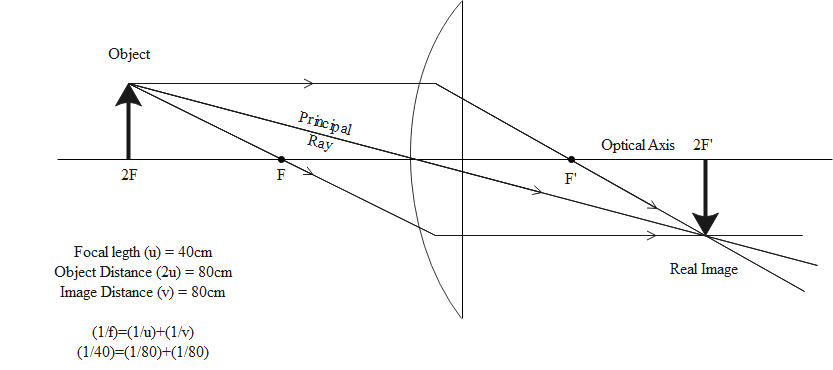
The radius of curvature of the convex surface of a thin plano-convex lens (refractive index 1.5) is 20cm (i) Calculate the focal length of the lens. (ii) Also calculate the distance of the image of a pin placed on the axis 80cm from the lens and draw a ray diagram. (iii) Determine the magnification of the image.
(A) (a)40cm
(b)$80c{m^2}$, on the other side of the
(c) $+ 1$
(B) (a)50cm
(b)$700cm$, on the other side of the
(c) $ + 1$
(C) (a)40cm
(b)$80cm$, on the other side of the
(c)$ - 1$
(D) (a)$40c{m^2}$
(b)$80cm$, on the other side of the
(c)$ - 1$
Answer
216.6k+ views
Hint In Optics, magnification is simply the size of an image relative to the size of the object creating it. Magnification refers to the ratio of the length of image to the length of object measured in the plane perpendicular to the optical axis. The distance between the centre of a lens or curved mirror is known as its focal length.
Complete step by step answer: In optics, the lens makers formula states that
$\dfrac{1}{f} = \left( {\mu - 1} \right)\left( {\dfrac{1}{{{R_1}}} - \dfrac{1}{{{R_2}}}} \right)$
Where f is the focal length.
${R_1} = \infty $
${R_2} = 20cm$
Therefore, we can put the given information in the above equation and derive,
(i)$\dfrac{1}{f} = \left( {1 \cdot 5 - 1} \right)\left( {\dfrac{1}{{20}}} \right)$
Hence,
f = 40cm
(ii) Since, focal length (f) = 40cm
Let v = distance of image and let u = distance of object
Therefore,
$\dfrac{1}{u} + \dfrac{1}{v} = \dfrac{1}{f}$
$ \Rightarrow \dfrac{1}{{80}} + \dfrac{1}{v} = \dfrac{1}{{40}}$
$\Rightarrow v = 80cm$
The given diagram clearly demonstrates the solution.
(iii) Let magnification = m
$m = - \dfrac{v}{u}$
$\Rightarrow m = - \dfrac{{80}}{{80}}$
$ m = - 1$
Hence, the correct answer is Option C.
Note We must carefully understand if the lens is silvered anywhere as that would bring reflection in the question and the solution for which would completely be different. Other than that, the complexity of the question increases with involvement of more than one lens in case of which the formula used will be relative.

Complete step by step answer: In optics, the lens makers formula states that
$\dfrac{1}{f} = \left( {\mu - 1} \right)\left( {\dfrac{1}{{{R_1}}} - \dfrac{1}{{{R_2}}}} \right)$
Where f is the focal length.
${R_1} = \infty $
${R_2} = 20cm$
Therefore, we can put the given information in the above equation and derive,
(i)$\dfrac{1}{f} = \left( {1 \cdot 5 - 1} \right)\left( {\dfrac{1}{{20}}} \right)$
Hence,
f = 40cm
(ii) Since, focal length (f) = 40cm
Let v = distance of image and let u = distance of object
Therefore,
$\dfrac{1}{u} + \dfrac{1}{v} = \dfrac{1}{f}$
$ \Rightarrow \dfrac{1}{{80}} + \dfrac{1}{v} = \dfrac{1}{{40}}$
$\Rightarrow v = 80cm$
The given diagram clearly demonstrates the solution.
(iii) Let magnification = m
$m = - \dfrac{v}{u}$
$\Rightarrow m = - \dfrac{{80}}{{80}}$
$ m = - 1$
Hence, the correct answer is Option C.
Note We must carefully understand if the lens is silvered anywhere as that would bring reflection in the question and the solution for which would completely be different. Other than that, the complexity of the question increases with involvement of more than one lens in case of which the formula used will be relative.
Recently Updated Pages
Wheatstone Bridge Explained: Working, Formula & Uses

Young’s Double Slit Experiment Derivation Explained

JEE Atomic Structure and Chemical Bonding important Concepts and Tips

JEE Amino Acids and Peptides Important Concepts and Tips for Exam Preparation

Electricity and Magnetism Explained: Key Concepts & Applications

Chemical Properties of Hydrogen - Important Concepts for JEE Exam Preparation

Trending doubts
JEE Main 2026: Application Form Open, Exam Dates, Syllabus, Eligibility & Question Papers

Derivation of Equation of Trajectory Explained for Students

Hybridisation in Chemistry – Concept, Types & Applications

Understanding the Angle of Deviation in a Prism

Understanding Collisions: Types and Examples for Students

How to Convert a Galvanometer into an Ammeter or Voltmeter

Other Pages
JEE Advanced Marks vs Ranks 2025: Understanding Category-wise Qualifying Marks and Previous Year Cut-offs

Understanding Atomic Structure for Beginners

Ideal and Non-Ideal Solutions Explained for Class 12 Chemistry

Degree of Dissociation: Meaning, Formula, Calculation & Uses

Understanding Electromagnetic Waves and Their Importance

Understanding the Electric Field of a Uniformly Charged Ring




